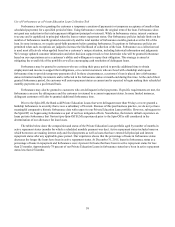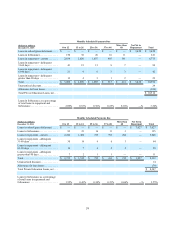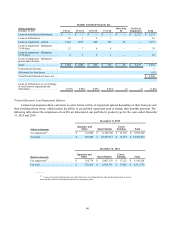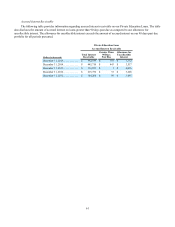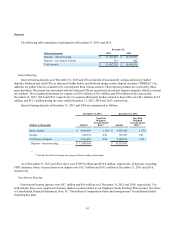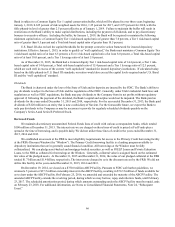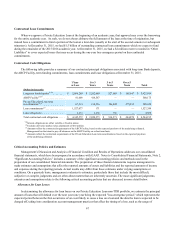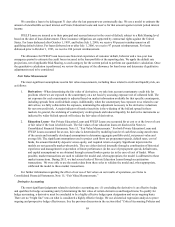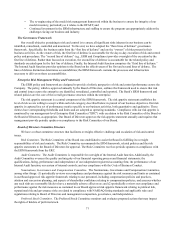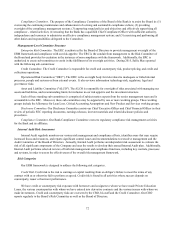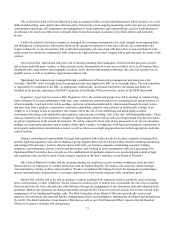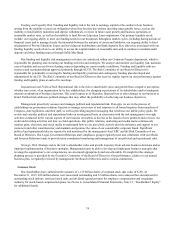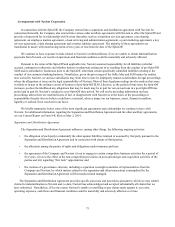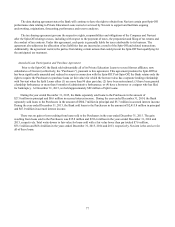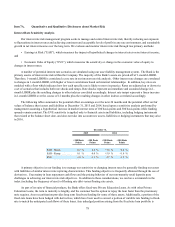Sallie Mae 2015 Annual Report Download - page 70
Download and view the complete annual report
Please find page 70 of the 2015 Sallie Mae annual report below. You can navigate through the pages in the report by either clicking on the pages listed below, or by using the keyword search tool below to find specific information within the annual report.68
forbearance) and how much we expect to recover over the same one year period related to the defaulted amount. The expected
defaults less our expected recoveries adjusted for any qualitative factors (discussed below) equal the allowance related to this
portfolio. Our historical experience indicates that, on average, the time between the date that a customer experiences a default
causing event (i.e., the loss trigger event) and the date that we charge off the unrecoverable portion of that loan is one year.
In estimating both the non-TDR and TDR allowance amounts, we start with historical experience of customer
delinquency and default behavior. We make judgments about which historical period to start with and then make further
judgments about whether that historical experience is representative of future expectations and whether additional adjustments
may be needed to those historical default rates. We may also take certain other qualitative factors into consideration when
calculating the allowance for loan losses. These qualitative factors include, but are not limited to, changes in the economic
environment, changes in lending policies and procedures, including changes in underwriting standards and collection, charge-
off and recovery practices not already included in the analysis, and the effect of other external factors such as legal and
regulatory requirements on the level of estimated credit losses.
Our non-TDR allowance for loan losses is estimated using an analysis of delinquent and current accounts. Our model is
used to estimate the likelihood that a loan receivable may progress through the various delinquency stages and ultimately
charge off (“roll rate analysis”). Once a charge-off forecast is estimated, a recovery assumption is layered on top.
In connection with the Spin-Off, we changed our charge-off policy for Private Education Loans to charging off loans
when the loans reach 120 days delinquent. Pre-Spin-Off SLM default aversion strategies were focused on the final stages of
delinquency, from 150 days to 212 days. Our default aversion strategies are now focused on loans that are 30 to 120 days
delinquent.
The roll rate analysis model is based upon actual historical collection experience using the 120 day charge-off default
aversion strategies. Once the quantitative calculation is performed, we review the adequacy of the allowance for loan losses and
determine if qualitative adjustments need to be considered.
Separately, for our TDR portfolio, we estimate an allowance amount sufficient to cover life-of-loan expected losses
through an impairment calculation based on the difference between the loan’s basis and the present value of expected future
cash flows (which would include life-of-loan default and recovery assumptions) discounted at the loan’s original effective
interest rate.
Our TDR portfolio is comprised mostly of loans with interest rate reductions and forbearance usage greater than three
months. All of our loans are collectively assessed for impairment, except for loans classified as TDRs (where we conduct
individual assessments of impairment). We modify the terms of loans for certain borrowers when we believe such modifications
may increase the ability and willingness of a borrower to make payments and thus increase the ultimate overall amount
collected on a loan. These modifications generally take the form of a forbearance, a temporary interest rate reduction or an
extended repayment plan. In the first nine months after a loan enters full principal and interest repayment, the loan may be in
forbearance for up to six months without it being classified as a TDR. Once the initial nine-month period described above is
over, however, any loan that receives more than three months of forbearance in a twenty-four month period is classified as a
TDR. Also, a loan becomes a TDR when it is modified to reduce the interest rate on the loan (regardless of when such
modification occurs and/or whether such interest rate reduction is temporary). The majority of our loans that are considered
TDRs involve a temporary forbearance of payments and do not change the contractual interest rate of the loan.
The separate allowance estimates for our TDR and non-TDR portfolios are combined into our total allowance for Private
Education Loan losses. The evaluation of the allowance for loan losses is inherently subjective, as it requires material estimates
and assumptions that may be susceptible to significant changes. If actual future performance in delinquency, charge-offs or
recoveries is significantly different than estimated, this could materially affect our estimate of the allowance for loan losses and
the related provision for credit losses on our income statement.
As part of concluding on the adequacy of the allowance for loan loss, we review key allowance and loan metrics. The
most relevant of these metrics are the allowance coverage of charge-offs ratio; the allowance as a percentage of total loans and
of loans in repayment; and delinquency and forbearance percentages.


